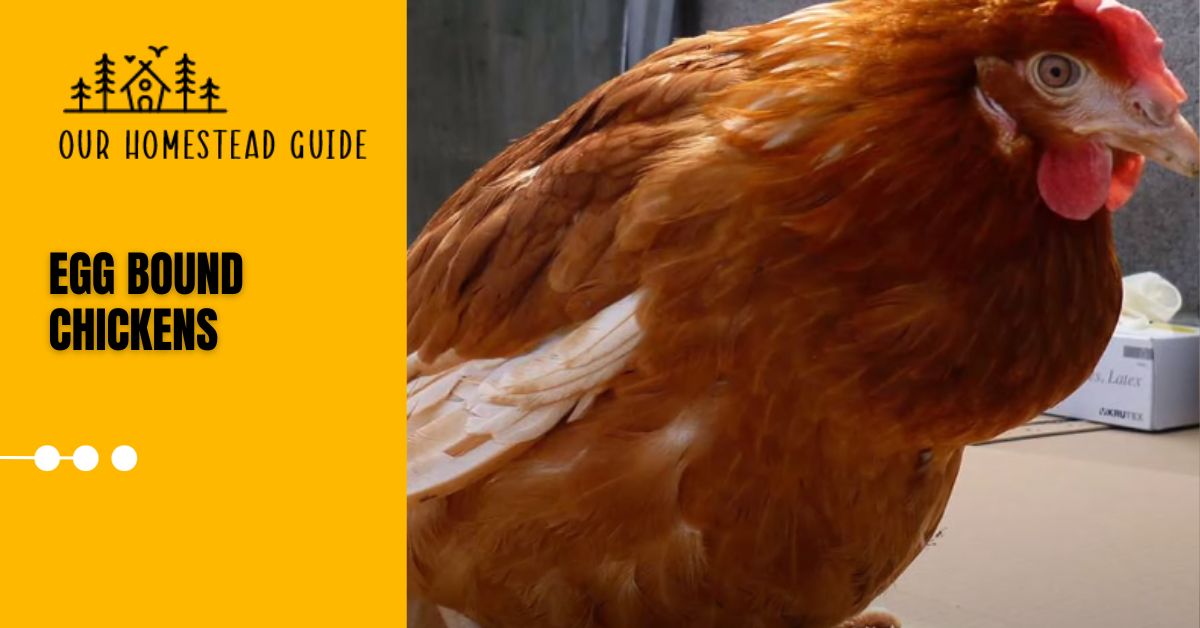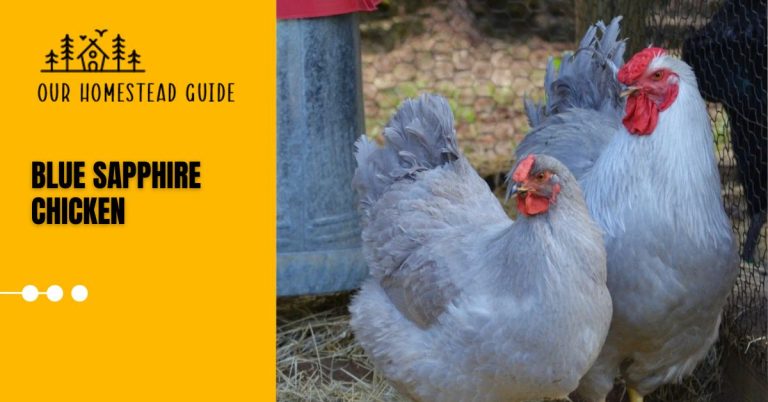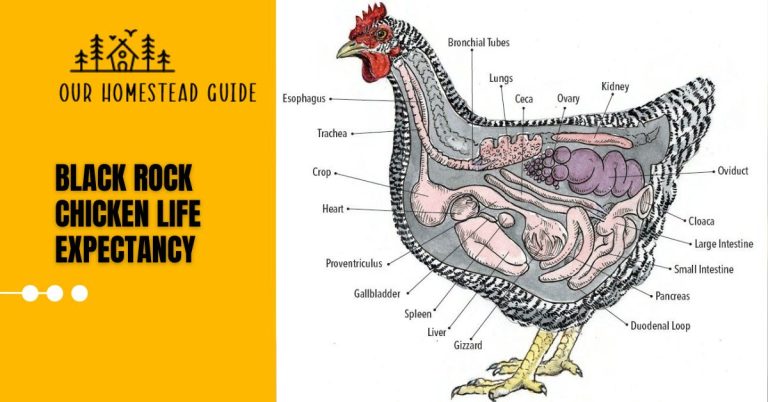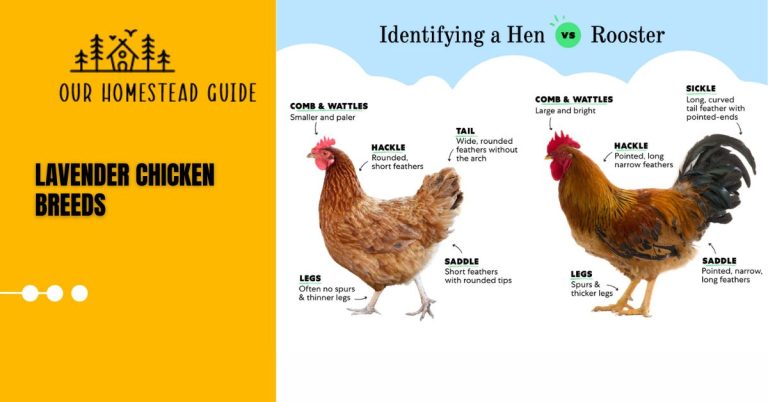Egg Bound Chickens: Complete Guide to Care & Support
Egg Bound Chickens, A chicken’s health is at stake when an egg binds itself inside of it. Keep an eye out for symptoms including straining, infrequent egg laying, and enlarged abdomen. There’s not much time left! To securely remove the egg and save your feathery buddy from possible death, seek quick veterinarian attention.
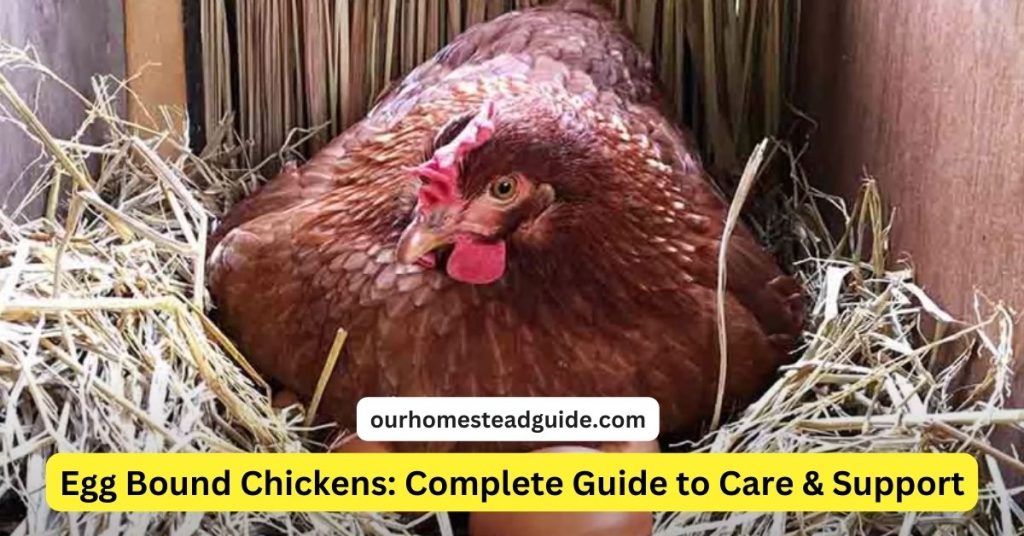
Egg Bound Chickens Care & Support
To help an egg-bound chicken safely deliver the egg, you must provide it with timely attention and supportive measures. This is a comprehensive guide on sustaining and taking care of an egg-bound chicken:
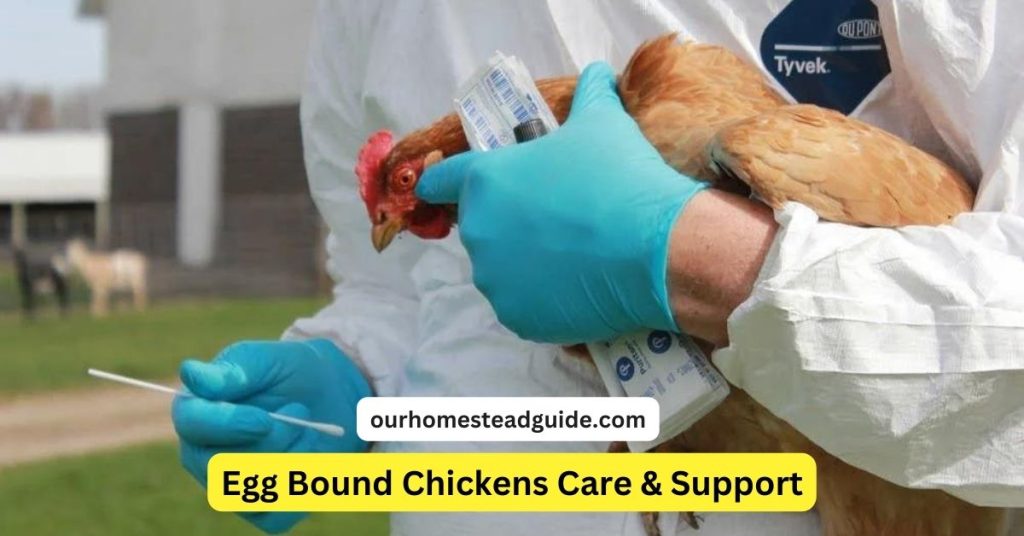
- Set the Hen Apart:
To ease stress and provide concentrated care, remove the egg-bound hen from the flock.
- Inspect and Verify:
To make sure there is an egg within, carefully check the hen’s abdomen. Take care not to crack the egg when inspecting it.
- Grease the Air Vent:
To lubricate the vent, use a lubricating ointment or, in case it’s not available, vegetable or olive oil. This aids in making the egg’s transit easier.
- Establish a Cozy Environment:
Create a cozy, calm, and welcoming atmosphere. Steer clear of the 90–100 degree Fahrenheit range.
In a small space, like a brooder, provide clean bedding to provide a calm environment.
5. Warm Water Bath:
After adding some warm (not boiling) water to a container or sink, let the hen soak for around ten minutes. Make sure the water reaches her chest.
A quarter cup of Epsom salts can be optionally added to the water.
- Light Massage:
Gently massage the hen’s belly while she’s in the water. This may encourage contractions and facilitate the egg’s migration.
- Provide Water and Food:
Urge the hen to consume food. If she declines, offer her sugar water to give her more energy.
To treat any possible calcium shortages, include a calcium supplement in her diet.
- Offer Calm and Quiet:
Give the hen some alone time in the designated container following the wash and massage. The natural process is encouraged by less stress and disruption.
- Carry Out the Procedure Again:
Repeat the warm water bath and massage cycle if, after the first try, there is no indication of the egg being laid.
- Watch and Speak with a Vet:
Pay special attention to the hen’s health. When all attempts fail to pass the egg, seek immediate advice from a veterinarian experienced with chickens.
- After Laying Eggs:
After the hen lays her egg, pat her dry and put her in a cozy, warm spot.
Make sure she has access to food and drink, and keep a watchful eye out for any indications of weakness or distress.
- Preventive actions:
- Provide a premium layer feed that is both balanced and meets nutritional needs.
- Make sure that clean water is available, and think about providing a calcium supplement.
- Provide enough room for exercise to improve general health.
- To prevent egg-laying delays, make sure there are enough nest boxes available.
- To spot any early warning indicators of health problems, spend time regularly monitoring and interacting with the flock.
What Does Chicken Egg Binding Entail?
When a hen can’t pass an egg that’s stuck in the oviduct, it causes egg binding. This obstruction can also happen close to the vent, usually between the uterus and cloaca. Egg binding not only prevents a chicken from laying more eggs but also interferes with its ability to digest food.
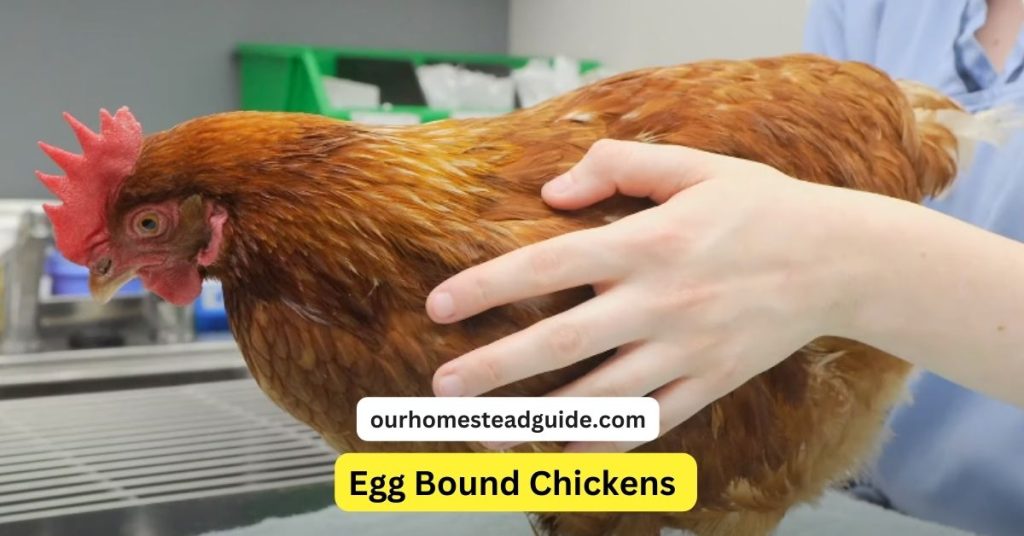
A hen’s cloaca seals the intestinal hole to stop contamination when she is ready to deposit an egg. The chicken cannot urinate if its cloaca closes because it cannot pass the egg. Constipation is deadly to hens and can cause death in less than 48 hours.
Egg binding can lead to a number of problems, including as infections in the coelomic cavity and egg yolk peritonitis. Furthermore, it might result in vent prolapse, a condition in which the chicken’s vent emerges from its back.
This illness may serve as a prelude to infection and set off cannibalistic behavior in the flock. It’s imperative to treat egg binding as soon as possible to spare the afflicted chicken from severe repercussions.
What Are The Symptoms of an Egg Bound Chicken?
A chicken that is egg-bound will exhibit frailty, decreased appetite, and a panting respiration rate. Hens that are confined to eggs may have strained abdomens and become lame due to the pressure of the imprisoned egg on the pelvic nerves. There may also be fecal changes that resemble diarrhea in smaller chickens or constipation.
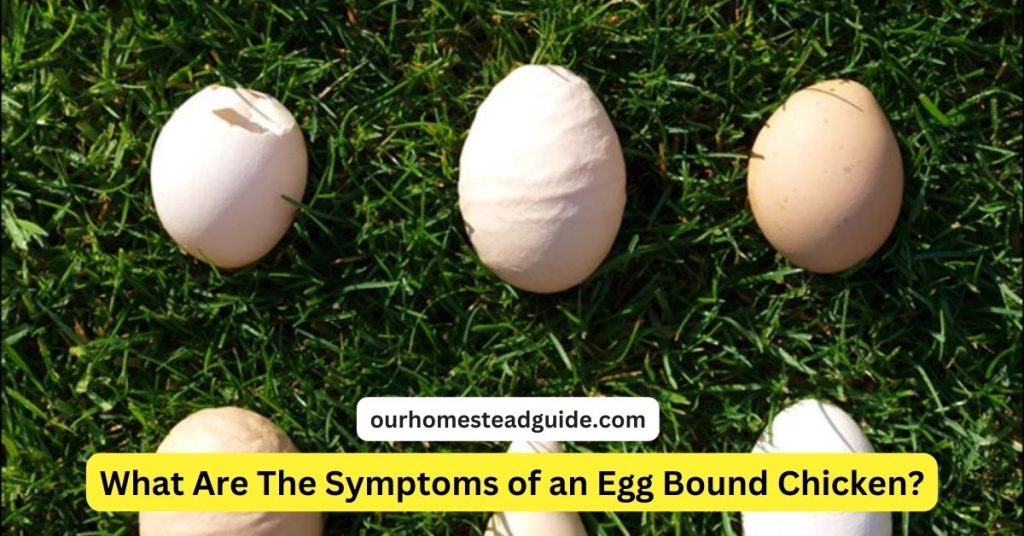
Weakened appearances are frequently indicative of a problem that has to be addressed right away if these symptoms materialize. Egg binding is unusual, but if left untreated, can cause major health problems, including death. For this reason, early identification is critical.
Causes of Egg Binding in Chickens
It might be very confusing to attempt to figure out how your chicken became egg bound in the first place. This is due to the fact that there are several factors that might create an egg-bound chicken, and it can be challenging to identify them all.
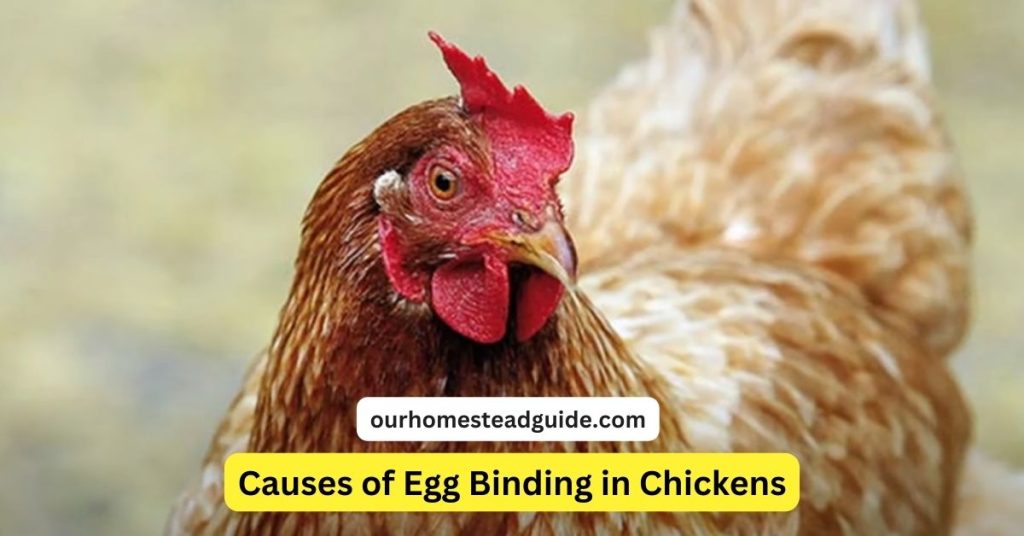
Egg binding can occasionally be a one-time event for which there is little you can do to stop it. For instance, your hen may get egg-bound if she tries to lay an oddly huge or oddly shaped egg.
This is due to the oviduct’s restricted range of motion, which makes it easy for eggs that don’t fit the typical pattern to become lodged and trapped. Similarly, while you may like having double-yolked eggs in your egg basket, they are sometimes very large and challenging for chickens to lay.
Reproductive problems may potentially be the cause of egg binding. While some of these are one-time events, others may represent problems to which certain hens may be susceptible. If you notice that a particular hen consistently lays irregularly shaped eggs, it may be due to genetic problems that also increase her risk of egg binding.
The age of your hens and malnutrition are two easier-to-prevent reasons of egg binding. In other words, because they don’t lay as many eggs, older hens have a higher likelihood of being gg bound because their muscles are weaker and less flexible due to their increased inactivity and decreased ability to pass eggs.
A hen that is malnourished and whose food is deficient in important vitamins, minerals, and protein—including but not limited to calcium—has an increased risk of developing egg binding. Obese or sedentary hens might also be in danger.
Egg binding can result from diseases and infections. Reproductive tract infections and some intestinal parasites can also result in egg binding. These are less frequent in most backyard flocks since they are frequently avoidable via basic animal husbandry methods.
Finally, a hen who does not have ample access to a nest box may be more likely to become egg bound. This is because she will feel tempted to hold her egg until she finds a spot. Egg binding can also be caused by a stressed hen, for example, one who is hesitant to lay an egg because predators have been lurking around the coop.
Treatments for an Egg Bound Chicken
Here are some potential treatments for egg bound chickens:
Identify the Problem
The first step in treating a hen that is egg bound is to ascertain whether the hen is indeed egg confined or whether there is another health issue that is causing her discomfort. Treat her in any way only when you are certain that this is the precise cause of her suffering.
Make careful to lubricate it with lubricating jelly and put on a glove. This will shield your hen’s fragile vent from any ripping or injury. Press lightly into the vent with your finger, around two inches in. You will be able to feel if there is an egg that is trapped. The problem is not with egg binding if you experience no symptoms.
Give Her a Bubble Bath
No actual bubbles required, though!
Egg-bound hens can be identified by looking for symptoms such as a bloated belly, straining, and lethargic behavior. Take quick action and get the chicken veterinary care right away to prevent complications or death. An egg-bound chicken’s survival depends on early intervention.
Put the hen in a warm bath with Epsom salts for around 20 minutes to help her loosen a trapped egg. After gently patting her dry, dab the vent with lubricating gel and give her a little massage to induce contractions. Take care not to crack the egg because that might result in an infection. After several tries, if the egg still doesn’t pass, speak with a veterinarian about available treatments.
Encourage Her Hunger
Give your hen a sugar water solution if she hasn’t been eating because of her stuck egg. This will replenish any lost nutrients and lubricate the egg from the inside out.
Give Calcium
Many individuals supplement with calcium in addition to the previously mentioned bath therapy. Your hen will be able to discharge the egg more readily and her oviduct will contract more easily with calcium. If you decide to do this, give your hen some calcium immediately before you immerse her in the water; just be careful to break it up into tiny bits to avoid aggravating her further.
Warm Towel Care
Another alternative if you can’t persuade your hen to sit in the water is to have her sit on a warm, damp towel. Put her in a small area to do this. She might not sit down unless you hold the towel against her. The warm wetness is said to aid in the egg’s release.
Removing a Stuck Egg
A stuck egg may be difficult to free on your own, so proceed with utmost caution. The hen may be at risk if you are not completely confident in your abilities. Instead, you ought to get veterinary care whenever it is feasible.
You must pierce the egg to release the contents with a syringe in order to remove it. After the contents are removed, you ought to extract the shell. Again, proceed with caution to avoid cracking the egg within. Make sure you have removed every item in case it breaks.
You face the danger of becoming infected if you don’t remove the fragments. The tiny fragments have the potential to cause severe discomfort and perhaps injury to your hen by severing the oviduct’s inside. You’ll need an antibiotic to treat her and stop infection if an egg breaks.
You can let the hen rest if you don’t want to remove the shell. In fact, several vets advise against doing this. Due to the egg no longer being a solid mass, it is frequently easier for the hen. You may have to play the anxious game of watching and waiting for her to pass the remaining shell, which can take many days.
This technique functions best when the egg is visible. If not, you will have to use massage techniques to help move it in the direction of the vent.
Once more, take caution as this may result in breaking. Return to the box and keep a watchful eye on her to make sure she is eating, acting, and drinking normally if you are successful in getting the egg out of this region.
Additionally, you should check her for edema or vent prolapse. You should wait to put her back with the flock if there is any redness or swelling, even if she is acting normally, since they will peck at the tender spot.
Preventing Egg Binding
A female bird’s inability to deliver an egg via the reproductive system is known as egg binding. It’s a potentially fatal illness that may be rather terrible. Egg binding can happen in other species as well, however it is more prevalent in companion birds like budgies, cockatiels, and parakeets. The following basic advice can assist in preventing bird egg binding:
Proper Nutrition:
Make sure the food your bird is eating is healthy and well-balanced. For birds that are prone to egg binding, a diet high in calcium is particularly critical. To find the right food for your bird’s age and species, speak with a veterinarian.
Calcium Supplements:
Make calcium supplements available. Your veterinarian may suggest calcium supplements, mineral blocks, or cuttlebones as a means of doing this. Enough calcium is essential for the development of eggshells.
Natural Light Exposure:
A bird’s reproductive cycle can be regulated by exposure to full-spectrum illumination or natural sunshine. Hormonal changes brought about by proper illumination can help promote a more regular reproductive cycle.
Limit Nesting Material:
Cut down on the amount of nesting material available. A bird’s innate need to lay eggs might be triggered by an abundance of nesting material. Keep the amount of cloth, shredded paper, and other nest-building materials in the cage to a minimum.
Maintain a Stable Environment:
Make sure the bird lives in a secure, stress-free environment. A bird may get stressed due to environmental changes or the presence of predators, including other pets, which can lead to egg binding.
Proper Cage Size:
Provide a cage that is the right size. An inadequately sized cage might lead to tension and hinder the bird’s capacity for activity, ultimately affecting its general well-being.
Regular Veterinary Check-ups:
Make an appointment for routine examinations with an avian veterinarian. Getting regular veterinarian treatment will help guarantee that your bird is healthy and identify possible problems early on.
Monitoring Behavior:
Observe how your bird is acting. See a veterinarian right once if you observe any changes, such as lethargy, breathing difficulties, or straining.
Step 1: Recognize the Signs
In a chicken, look for indications of weakness, appetite loss, and panting. Look for symptoms of egg binding, such as straining in the abdomen, lameness, and irregular feces.
Step 2: Check for the Presence of an Egg
Feel for the existence of an egg by lightly tapping the abdomen. The egg is often tactile.
Step 3: Seek Veterinary Assistance
To confirm the diagnosis, speak with a veterinarian who has experience treating poultry if you think you may have egg binding and the symptoms continue.
Step 4: Lubricate the Vent
Use a lubricating ointment or vegetable/olive oil to lubricate the vent if a veterinarian is not accessible. For this, put on medical exam gloves.
Step 5: Create a Comfortable Environment
Fill a container with new bedding and keep it between ninety and one hundred degrees Fahrenheit.
For around ten minutes, give the abdomen a warm water bath with Epsom salts (optional), gently rubbing it throughout.
Step 6: Offer Food and Water
Urge the bird to begin eating. Give her some sugar water for energy if she refuses.
To treat any calcium inadequacies that could be causing egg binding, take an additional supplement.
Step 7: Provide peace
To help the chicken lay eggs, give it some alone time in a peaceful area.
Step 8: Repeat the Process
Continue the warm water bath and massage cycle until the egg is laid if the initial attempt at passing the egg is unsuccessful.
Step 9: Consult a Vet if Needed
See a veterinarian right away if, despite your best efforts, the egg fails to hatch. An egg-bound hen has only 48 hours to live before she might perish, so timing is everything.
Step 10: Prevention Measures
- Give your hens high-quality layer feed.
- Make sure you have access to a calcium supplement and clean water.
- To lower the risk of egg binding, give yourself plenty of space to exercise.
- Don’t forget to supply enough nest boxes to prevent egg-laying delays.
- Every day, spend time with your flock to identify any behavioral changes early on.
Step 11: General Care Tips
Be present in your flock and keep a frequent eye out for typical behavior.
Join subscription services such as Hobby Farm Guys to stay up to date on animal husbandry.
Why You Need to Avoid Egg Bound Chickens
Serious hazards, including discomfort and even consequences including organ rupture and internal hemorrhage, are associated with egg binding in chickens. Infection risk is increased by the condition, which may also result in systemic health problems.
Persistent instances may reduce egg production, which would affect the chickens’ total productivity. Keepers of poultry need to be on the lookout for symptoms of egg binding, take early action to resolve problems, and see a veterinarian to ensure the health of their flock.
Most Frequently Asked Questions!
Q1: What is egg binding in chickens?
When an egg is placed in the reproductive system, a hen with egg binding is unable to evacuate it. It may result in severe health issues.
Q2: What are the signs of egg binding in chickens?
Lethargy, trouble walking, fluffed feathers, straining, and spending a lot of time in the nesting box without laying an egg are all warning signs.
Q3: How can I prevent egg binding in my chickens?
Lethargy, trouble walking, fluffed feathers, straining, and staying in the nesting box for long periods of time without laying an egg are all indicators.
Q4: What should I do if I suspect my chicken is egg-bound?
Seek out veterinarian care right away. When addressing egg binding, timing is crucial. Your veterinarian can suggest hand-extracted eggs, warm baths, or calcium supplements.
Q5: Can egg binding be fatal for chickens?
Yes, egg binding can seriously endanger a chicken’s life if it is not treated quickly. Complications can include internal bleeding, organ rupture, and infections.
Q6: How often do chickens experience egg binding?
Although the incidence varies, vulnerability is influenced by age, breed, and general health. Risk can be decreased with the right attention and supervision.
Q7: What is the long-term impact of chronic egg binding?
Chronic cases may reduce egg production and impact the overall health and productivity of the hen. Regular veterinary care and preventive measures are crucial.
Q8: Can egg binding be prevented with a specific diet?
Yes, avoiding egg binding requires a well-balanced diet high in calcium. See a vet if you want a diet specially designed for your chicken.
you may also like this article.

